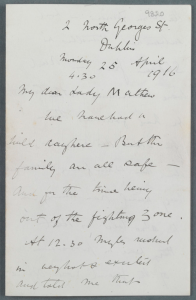
Philip Costello retired in 2012, having completed 40 years in the Public Service. He is married to Catherine and they have four children and two grandchildren. Since his retirement he has been volunteering at various festivals in Dublin as well as the Letters 1916 Project.
Philip told us about his involvement with the Letters of 1916 project.
In late 2013 I heard a piece about the Letters 1916 Project on radio and it motivated me to explore the website and sign up. I was particularly drawn by the fact that this was something I could do at any time in my own home or, subject to Wi-Fi availability, on the move. After a slow start and some valuable assistance from the team, I was transcribing in no time at all.
Most of my transcribing to date has been in the categories of World War 1, and Irish Question – these have taken me on a journey through trench life in France, life in prison camps in Germany, Roger Casement’s activity in Germany, his largely unsuccessful efforts to recruit volunteers, through to his arrest, incarceration, trial, and execution. Much of the Casement story was new to me and led me into further research and reading.
When I first began transcribing there were very few letters available for transcribing in the Easter Rising Ireland 1916 category. However, by the time I had cleared a large amount from my other two chosen categories, I went back and found a fresh crop of 1916 material.
Having been around for the 50th anniversary commemoration in 1966 (for my part I read the Proclamation on the steps of my Primary School), I am especially happy to be part of this project which will have made significant progress by Centenary year 2016. The Easter Rising letters have given me a lot of additional insight and, again has led me into further research and reading.
By the beginning of February 2014 I had transcribed over 150 letters, so I was honoured to be asked to participate in an RTE News feature on the project by Philip Bromwell. I have recently graduated to uploading letters to the project and my contribution in this area boosts the supply of letters for transcription for the growing number of transcribers. Uploading has been a slower process for me so it is a great relief to know that the team provides excellent and swift support.
Nowadays, I’ll still opt for an occasional transcription for a more immediate buzz – it really is addictive! Recently I saw a headline on the website about a 110 page letter which had been uploaded. The temptation proved too much so I immediately jumped in.

The letter was a narrative written between 25 April and 1 May 1916. It was written by John Dillon, M.P., who resided close to the fighting and who, apart from attending Mass once and a quick visit to a local hotel, spent the entire time in his house at 2, North Great George’s Street. His description of the gunfire, explosions, and fire, the disruption of sleep, are very atmospheric. He describes women and girls passing up the street with the spoils of their looting. Dillon is frustrated at the lack of news, and much of the information getting through to him is rumour and counter-rumour. Information comes via his own children, the bread man, clergy, a nurse, a hotel worker, and others. Underlining this is a comment overheard on the street by his son after the surrender – that “it was Mr John Dillon who made the peace- God bless him – sure he’s a grand man – he went down to the G.P.O. – and arranged for peace”.
Clearly, the job of the historian is anything but straightforward!
Philip’s Twitter profile is @phcostel and his own website is currently under construction.